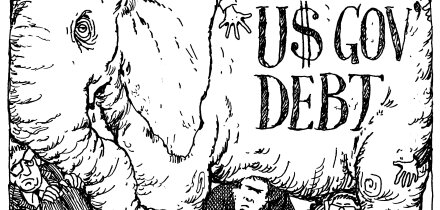This Learning Curve will focus on the empirical application of option replication rather than the theoretical foundation. We restrict ourselves to the foreign exchange markets where transaction costs are low and liquidity high. These two factors are indeed the necessary conditions for the use, if at all, of dynamic strategies.
Replicating Strategies
A call option on forward contracts can be created synthetically by purchasing an appropriate number of forward contracts. As prices rise and the synthetic option moves further in the money, the size of forwards to hold long increases. The exact size of forward contracts at any time is given by the hedge ratio or the first derivative of the Black-Scholes pricing model.
Because instantaneous adjustments are impossible, rebalancing can occur either after prices have moved some minimal amount or at a fixed frequency. We adopt a mixture of the two approaches while replicating a one-month option. At first, we systematically rebalance daily at midday London time to avoid gapping and closed markets. The composition for the replicating portfolio does not solely depend on the changes in the underlying asset price but also on the remaining time-to expiration. Therefore we also adjust the position as a function of the delta moves rather than price alone. The thresholds for interventions have been arbitrarily fixed to 1, 2, 4, 7, 12, 20 and 30%. As a consequence, it may be impossible to find a strategy that duplicates exactly the returns of a call even when assuming zero transaction costs. Figure 1 illustrates our purpose by looking at a dollar/yen one-month call from October 1991 to December 2001. This specifically charts the relative performance of dynamic replication over a plain-vanilla call option. The biggest one-month deviations occurred in October 1998, during which the high-low range exceeded 25 big figures.
Empirical Evidence
To achieve a precise quantification of dynamic replication, we consider both calls and puts on three currency pairs against the dollar, namely the Deutsche Mark, the yen and sterling. We also take into account bid-ask spreads as specified in Table 1. Though replication may be successful before trading costs, net of trading costs it may fail.
Table 2 gives summary results. Tracking error is defined as the annualised standard deviation of the profit and loss from the dynamic strategy compared to purchasing the one-month call option. The standard deviations relative to the option pay-off are lowest for the smallest thresholds but the transaction costs highest. In other words, there is a cost attached to more accurate replications. Overall, dynamic strategies are rather cheaper than plain-vanilla options but the downside protection is smaller as can be seen from the minimum month statistics. The out-performance of replicating strategies is highly dependent on our assumptions. Firstly, bid-ask spreads have varied through time rather than being fixed. Secondly, we do not take into account potential slippage. As a consequence the results highlighted in this study could have been achieved only for small and medium transaction sizes.
Conclusion
Replicating strategies are an alternative to plain-vanilla options. Overall the performance compares well but some of the downside protection is lost. Further research should indicate if the excess returns are significant and can justify the use of daily forward adjustments rather than monthly option trading. More importantly the reasons behind the empirical out-performance will have to be investigated. Finally, the tolerance to risk and transaction costs will probably condition both the choice between option and cash replication as well as the delta threshold.
| Table 1:Bid-ask spreads in points | |||
| Currency Pair | USD/DEM | USD/JPY | USD/GBP |
| Spot | 9 | 5 | 5 |
| One-month forward | 10.5 | 6 | 6 |
| One-month option | 17 | 9 | 6.2 |
| Table 2: One-month options and replicating strategies as a function of the delta. Profit and loss in points including transaction costs from 31/10/1991 to 31/12/2001 | |||||||||
| Call USD/JPY | Option | 0% | 1% | 2% | 4% | 7% | 12% | 20% | 30% |
| Annualised Mean | 170 | 271 | 271 | 269 | 266 | 274 | 242 | 214 | 240 |
| Minimum Month | -288 | -479 | -476 | -480 | -480 | -456 | -519 | -604 | -604 |
| Annualised Tracking Error | 182 | 182 | 183 | 186 | 185 | 215 | 232 | 289 | |
| Annualised Transaction Costs | -54 | -60 | -60 | -59 | -56 | -52 | -45 | -40 | -32 |
| Put USD/JPY | Option | 0% | 1% | 2% | 4% | 7% | 12% | 20% | 30% |
| Annualised Mean | -220 | -119 | -118 | -120 | -124 | -115 | -149 | -170 | -145 |
| Minimum Month | -302 | -376 | -376 | -378 | -386 | -354 | -431 | -341 | -449 |
| Annualised Tracking Error | 182 | 182 | 182 | 186 | 185 | 215 | 232 | 291 | |
| Annualised Transaction Costs | -54 | -60 | -60 | -59 | -56 | -52 | -45 | -39 | -32 |
| Call USD/DEM | Option | 0% | 1% | 2% | 4% | 7% | 12% | 20% | 30% |
| Annualised Mean | -62 | 141 | 141 | 147 | 153 | 173 | 254 | 176 | 198 |
| Minimum Month | -427 | -449 | -450 | -450 | -467 | -453 | -425 | -393 | -500 |
| Annualised Tracking Error | 206 | 206 | 207 | 206 | 210 | 223 | 244 | 338 | |
| Annualised Transaction Costs | -102 | -116 | -115 | -114 | -109 | -100 | -86 | -76 | -64 |
| Put USD/DEM | Option | 0% | 1% | 2% | 4% | 7% | 12% | 20% | 30% |
| Annualised Mean | -608 | -406 | -406 | -398 | -393 | -372 | -302 | -367 | -319 |
| Minimum Month | -390 | -414 | -414 | -414 | -419 | -411 | -399 | -418 | -446 |
| Annualised Tracking Error | 205 | 205 | 207 | 206 | 210 | 222 | 246 | 336 | |
| Annualised Transaction Costs | -102 | -116 | -116 | -114 | -109 | -100 | -87 | -76 | -64 |
| Call USD/GBP | Option | 0% | 1% | 2% | 4% | 7% | 12% | 20% | 30% |
| Annualised Mean | -165 | -64 | -64 | -64 | -59 | -58 | -46 | -37 | -62 |
| Minimum Month | -125 | -120 | -123 | -123 | -121 | -120 | -114 | -127 | -150 |
| Annualised Tracking Error | 66 | 66 | 66 | 65 | 66 | 73 | 88 | 104 | |
| Annualised Transaction Costs | -30 | -40 | -40 | -39 | -37 | -35 | -31 | -27 | -23 |
| Put USD/GBP | Option | 0% | 1% | 2% | 4% | 7% | 12% | 20% | 30% |
| Annualised Mean | -187 | -86 | -86 | -88 | -82 | -81 | -69 | -56 | -83 |
| Minimum Month | -133 | -155 | -155 | -155 | -149 | -156 | -189 | -232 | -232 |
| Annualised Tracking Error | 66 | 65 | 66 | 65 | 66 | 73 | 88 | 104 | |
| Annualised Transaction Costs | -30 | -40 | -40 | -39 | -37 | -35 | -31 | -26 | -23 |
This week's Learning Curve was written by Hetty Colchester, FX analytics, and Emmanuel Acar, risk advisory group at Citibank in London.





